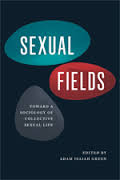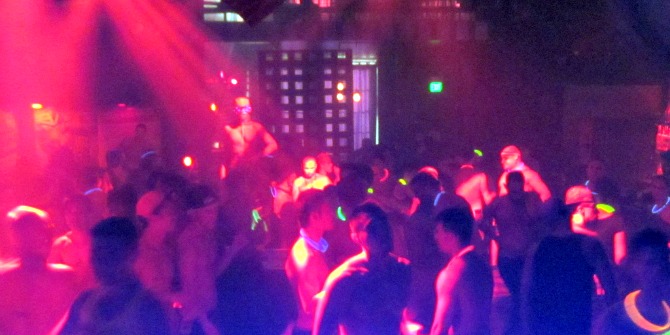Sexual Fields: Toward a Sociology of Collective Sexual Life provides an innovative and productive way of thinking about how sexual attitudes, desires, attractions, practices, and worlds are constructed, writes Megan Daigle. Adam Isaiah Green and contributors develop a distinctively sociological approach for analysing collective sexual life, where much of the sexual life of our society resides today. Students and researchers working on sexuality, gender, or queer studies should find something of interest in this book.
Sexual Fields: Toward a Sociology of Collective Sexual Life. Adam Isaiah Green (ed.). University of Chicago Press. December 2013.
 “Today, just outside the bedroom of the monogamous couple, there lies a terrain of erotic worlds, each one organized by the pursuit of intimate partnership and sexual pleasure yet with its own particular institutional and subcultural character”
“Today, just outside the bedroom of the monogamous couple, there lies a terrain of erotic worlds, each one organized by the pursuit of intimate partnership and sexual pleasure yet with its own particular institutional and subcultural character”
– Adam Isiah Green, Sexual Fields: Toward a Sociology of Collective Sexual Life, p.5
In Adam Isaiah Green’s new edited volume, sexuality is at once the subject of analysis and a tool for theorizing social action and community. Green draws on Bourdieu to propose a new sexual fields framework for understanding sexuality at the collective level.
Green argues that sexuality in the contemporary West has been “decoupled” from the institutions which once regulated it. We now have the unprecedented ability to meet like-minded people through mass communications, social media, world travel, and a multiplication of venues for mingling. Sexuality has become a “domain of social life in its own right”, structured by factors like gender, sexual orientation, race, ethnicity, age, social class, and – of course – sexual predilections of all kinds (pp.4, 10-11).
These myriad elements form what Green calls sexual fields: spaces that shape our “possibilities for partnership and, ultimately, our respective life paths” (p.4). They can be physical or virtual sites, wherein individuals meet, vie for partners, and locate themselves within logics of attractiveness, esteem, and desirability. Green notes that sexual fields are both horizontally differentiated (men and women in heterosexual fields, butches and femmes in some lesbian fields) and vertically stratified by “tiers of desirability” (pp.29-30, 32). Desirability is not just about being sexy, or possessing sexual capital in Bourdieusian terms, but rather it is about “capital portfolios”, where social, financial, and cultural capital also figure, depending on the field(s).
Most notably, Green’s analysis moves the study of desire and desirability from the level of subjective and “idiosyncratic” (p.15) personal tastes to the collective, where notions of desirability are created and maintained intersubjectively, and the individual is socialized into the field’s patterns of desire and value. This move is not just a matter of scale; rather, it helps us to see how our desires themselves can be shaped by the circles in which we move, the groups amongst whom we find acceptance and actualization, and the activities and spaces that we frequent in search of love, sex, and companionship.

Moving from theory to practice, Williams and Weinberg describe a bar in San Francisco where cisgendered men come to meet, flirt with, and sometimes have sex with transgender women. Their work shows the bar to be a kind of microcosmic sexual field, complete with its own structures of desire, tiers of desirability, and distributions of capital (pp.58-60). The transwomen operate within a logic of passing, wherein those who achieve a more feminine and womanly presentation are considered more desirable, even as they balance this against the fear of homophobic violence if they ‘fool’ a potential date by passing too well. The men, whether they identify as straight or bisexual, value the bar for the attention they receive from beautiful transwomen and for the escapism of the space itself. Their interactions are what Williams and Weinberg call an “intersubjective dance” where desiring and being desired are bound up together (p.62).
Hennen, on the other hand, challenges Green by arguing that sexual fields need not necessarily be characterized by stratification. He explores the foundation of the leather scene in the post-war USA and its strict ideal of muscled, stoic masculinity, in part a reaction to views of gay men as effeminate. Later, the bear community emerged in rebellion against the cold, objectified, and body-policing world of the leathermen. Where the leathermen engaged in often-anonymous sex and valued an archetypal male physique, the bears fostered a warm and democratic culture that rejected hierarchies of attractiveness. Importantly, Hennen uses Green’s framework to show how individual desires can be moulded by factors like war trauma and cultures of body image, rejecting the idea of that fields simply “liberate already-existing preferences” (p.77). Through interviews, Hennen shows that many men joined the leather community in search of camaraderie and healing after leaving the army, rather than for sex. Likewise, many more joined the bears’ sexual field looking for acceptance, no matter their body type or fitness, and found themselves more and more attracted to the bears themselves with time.
Finally, Farrer and Dale write from the Shanghai expat scene, where Western women are devalued by their male counterparts against a backdrop where young Chinese women are keen to date foreign men. Western women respond in a variety of ways – by lashing out on online forums, becoming ‘one of the guys’, dating Chinese men, lowering their standards for Western dates, or leaving Shanghai. Farrer and Dale’s is an account of “sexual mobility within and across fields” which shows how sexual desire can be learned, roles evolved, and tastes altered (p.145). It also sheds light on what the authors call “ethnosexual contact zones” (p.145) which exist in global cities like Shanghai, and arguably also in tourist hubs like the Caribbean and Southeast Asia, where locals and foreigners meet in an eroticized space. Farrer and Dale illustrate the often-exclusive nature of sexual fields and their axes of stratification. As the authors argue, “Shanghai is sexy – but not for everyone” (p.143).
These chapters left me with a two main questions. First, how can we delineate who is in (or out) of a particular field? The boundaries are certainly blurry, but Farrer and Dale’s essay in particular left me wondering if the Western women they studied are even in the field they want to be in, so marginal is their status. The authors themselves argue that, “foreign women simply do not exist within the sexual field of vision of these expatriate men” (p.153). This leads into my second query: what is the role of consent? Green touches on a related issue with the idea of “low sexual status”, which can lead to feelings of powerlessness. He argues that this could have outcomes including teenage pregnancy, the spread of STIs, and even rape and assault. Can one occupy a sexual field unknowingly? Can fields be coercive? These questions are not intended as critiques of the framework, but rather incitements for further research and discussion.
This book provides an innovative and productive way of thinking about how sexual attitudes, desires, attractions, practices, and worlds are constructed – one which could potentially prove useful beyond the discipline of sociology. In politics, for example, it could certainly facilitate the theorization of the intersection of political and sexual communities and movements. Students and researchers working on sexuality, gender, or queer studies should find something of interest in this book.
————————————–
Megan Daigle is a writer and researcher whose work focuses on international politics, gender, race, and sexuality. She is currently a postdoctoral research fellow at the Gothenburg Centre for Globalization and Development working on sexual violence in conflict. Her book, titled From Cuba with Love: Sexuality and the Governance of Bodies in Post-Soviet Cuba, is under contract with the University of California Press. She tweets @megandorothea. Read more reviews by Megan.








1 Comments